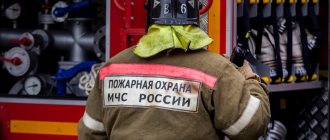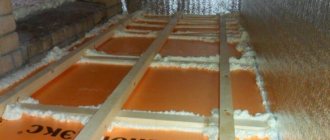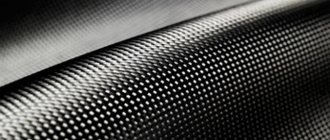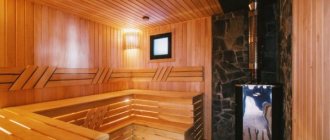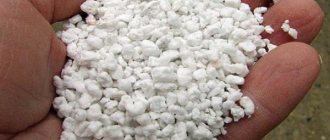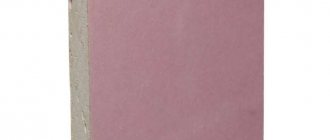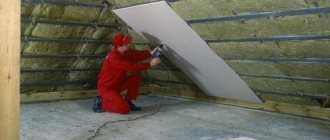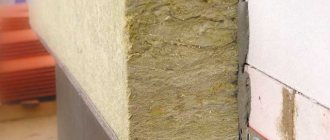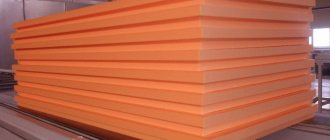Extruded polystyrene foam (EPS) is available in slab form. It is often called penoplex. But you should know that penoplex is a brand (the same as “Giprok” - drywall or “Macroflex” - polyurethane foam). The structure of the insulation under consideration is similar to the structure of conventional polystyrene foam. Being a subtype of polystyrene foam, penoplex is distinguished by its higher density and strength, and has a fine-celled, homogeneous structure consisting of almost completely closed cells. This material is the best type of polystyrene plastic. EPS (penoplex) is made by extrusion, as a result of which polystyrene beads melt, forming a homogeneous mass, which is poured into a mold, where it cools. In this article we will take a detailed look at penoplex insulation, its technical characteristics, advantages, applications and installation features..
Description and production of penoplex
Penoplex is an “improved version” of polystyrene foam, which is a derivative of polystyrene. The first installation for the production of extruded polystyrene foam, which, in essence, is penoplex, appeared in the USA more than 50 years ago. Today, this insulation is produced by companies all over the world, including in Russia.
The material is produced as follows: polystyrene granules are sent to a special chamber, where, under the influence of high temperature (130-140 degrees Celsius), they melt and foam using blowing agents. The latter are chemical substances that, when heated, actively produce gas (nitrogen, carbon dioxide).
As a result of this effect, the substance turns into a fluffy foam, reminiscent of whipped cream. Various fillers can also be added to it. Most often, components such as flame retardants (reduce flammability), antioxidants (prevent thermal oxidation and rapid destruction during storage and operation), antistatic agents (relieve stress), as well as light stabilizers, modifiers and other substances are introduced into the composition of penoplex.
The finished foam is squeezed out of the extruder and supplied to a transport belt, where it is given the final shape of slabs and blocks. After the material has completely hardened, an air gap remains in it. It is evenly distributed throughout the entire thickness. Gases make up 98% of the total volume of the heat insulator. The other two are polystyrene and additives.
High-quality penoplex insulation has a uniform porous structure with small cells, the size of which does not exceed 0.1-0.3 millimeters. They are filled with gas and isolated from each other. This structure guarantees the material excellent thermal insulation characteristics.
Extruded polystyrene foam Penoplex
Extruded polystyrene foam (EPS or XPS) is a modern thermal insulation material that appeared no more than 20 years ago, but managed to win the love of ordinary people thanks to its ability to solve a number of complex problems:
- provide reliable thermal insulation;
- reduce heating costs;
- ensure a healthy indoor microclimate.
is one of the largest domestic companies in the production of thermal insulation materials, and the undisputed leader in the production of extruded polystyrene foam, to which the popular name “penoplex” (sometimes spelled “penoplex”) is assigned.
Main types of penoplex
Penoplex can be used as insulation in the construction of new buildings, as well as for thermal insulation of old ones.
In addition, the universal material can be used for various surfaces and areas of the building. It is important to choose the right type of penoplex:
- Series
K. This material is created for thermal insulation of roofs and roofs. It is lightweight, waterproof and has a relatively low density - 28-33 kilograms per cubic meter. Can be used for pitched and flat roofs. - Series
C. Wall insulation. Its density ranges from 25 to 35 kilograms per cubic meter. It is used to insulate external and internal walls. - Series
F. Thermal insulator for foundations and basements. The material has special strength characteristics and high density - up to 37 kilograms per cubic meter. In addition, it is completely waterproof and biologically resistant. - Series "Comfort"
. This is the most versatile type of penoplex. Density - from 25 to 35 kilograms per cubic meter. It is used for insulation of city apartments, balconies, loggias. - Penoplex "45"
. This is the most durable type of heat insulator. The density of penoplex in this series is 35-47 kg/m3. Used in the construction of roads and runways. Effectively protects against the damaging effects of low temperatures.
In addition, foam sandwich panels have recently appeared on the construction market. This is an improved insulation material that is often used to insulate attics and facades. The panel consists of two or three layers. On one or both sides it is lined with cement bonded particle board.
Scope of application
Performance characteristics allow the use of polystyrene foam in various situations, both in domestic and industrial construction.
Insulation of façade walls from the outside
External wall insulation is considered the most effective. To do this, use the material of the Base or Wall ruler. Thermal insulation of external walls allows you to significantly save on heating costs in winter.
Insulation of the walls of a balcony or loggia
High heat-saving characteristics make it possible not only to insulate a balcony or loggia using penoplex, but also to make it an extension of the apartment, increasing the usable area of the room.
Roof thermal insulation
The roof is insulated using extruded polystyrene foam both from the inside and outside. At the same time, it is possible to combine various materials for external and internal thermal insulation to achieve a better result. Penoplex is ideal for both flat and pitched roofs.
Thermal insulation of concrete floor
Strength indicators allow the material to be used for floor insulation on concrete screed. This is also facilitated by low moisture and vapor permeability.
Technical characteristics of penoplex
The insulation has characteristics that make it attractive for industrial and private low-rise construction. Let's look at them:
- Thermal conductivity of penoplex
. The value of this indicator is only 0.03 W*m*S. This is much lower than many other insulation materials. Even getting wet does not reduce this indicator significantly. In places where there is high humidity, the thermal conductivity of penoplex increases by only 0.001-0.003 W*m*C. - Moisture resistance
. The material can be used to insulate roofs, attics, foundations and floors due to its ability to practically not absorb water and not lose its properties when wet. At the same time, penoplex can also act as a moisture-proof layer. A lot of tests were carried out on the insulation, in particular the material was immersed in water for a month. During the first 10 days, the heat insulator absorbed a small amount of liquid, after which it stopped. A month later, the amount of water in the penoplex slab was 0.6% of the volume. Thus, it was proven that moisture is capable of filling only the outer cells of the material, damaged by breaking or cutting. There cannot be water inside closed cells. - Vapor permeability
. Like all other polystyrene derivatives, penoplex is highly resistant to water evaporation. A layer of insulation about two centimeters thick has vapor permeability similar to a layer of roofing felt. - Chemical activity
. The insulation does not react chemically with most building mixtures and solutions. However, there is a group of substances that can disrupt the structure of penoplex and even completely dissolve it. These chemicals include: benzene, toluene, xylene and other hydrocarbons, formaldehyde, formalin, acetone, methyl ethyl ketone, various ethers, diesel fuel, kerosene, gasoline, coal tar, oil paints, polyesters, which are used as hardeners for epoxy resins. - Resistance to mechanical stress
. Even under heavy mechanical loads, penoplex does not change its shape and size. Extrusion makes it possible to obtain a material that is homogeneous in structure with tiny cells. This structure significantly improves the strength characteristics of penoplex. Compressive strength at ten percent linear deformation is 0.2-0.5 MPa. - Biological stability
. The heat insulator does not attract pests and microorganisms. Penoplex does not rot or decompose. However, many household rodents can easily damage the integrity of the slabs with their sharp teeth, making passages and holes in the insulation. - Operating temperature range
. To maintain its shape and properties, penoplex must be operated at certain temperatures. Typically, this operating range is indicated on the packaging of the material and depends on the density and brand. On average, this indicator fluctuates between -50-+75 degrees. If overheated, the insulation will melt and deform. If the temperature drops sharply, it will collapse. - Flammability
. Penoplex can belong to different fire safety classes (from G1 to G4) depending on the presence of fire retardants and other additives in the composition. In general, it is a flammable material that is capable of self-extinguishing, but when exposed to fire it emits acrid smoke. - Environmental friendliness
. Modern production technologies have made it possible to abandon the use of freons and phenol in the production process of penoplex. Therefore, the material does not contain any harmful volatile compounds. Over time, the insulation does not begin to produce toxic components; it can be safely used to insulate public institutions and residential buildings. - Lifetime
. According to recent studies, if installed correctly, penoplex can last at least 50 years without losing its qualities and properties.
Advantages of penoplex
The benefits of penoplex are very diverse. They concern exclusively high quality slabs from trusted manufacturers. The main advantages of insulation include:
- Excellent thermal conductivity
. Penoplex slabs can be used even in harsh winter conditions. They will reliably protect your home from the penetration of cold. In addition, repeated cycles of freezing and thawing do not harm the material in any way. - Light weight
. The material is very light, which greatly simplifies transportation, storage and work with it. In addition, even a weak foundation, ceilings and walls will withstand its weight. - Easy to install
. It will not be difficult to install penoplex slabs yourself, without the help of professional builders. It does not require special tools or expensive equipment. You can cut the material using a regular hacksaw. - High environmental performance
. You can work with penoplex boards without using personal protective equipment. They do not generate dust, do not emit harmful substances and do not irritate the skin if they come into contact with it. - Low price
. Penoplex is a relatively inexpensive material. On average, the cost of purchasing it pays off within three winters after installation.
Useful tips
Insulation using extruded polystyrene foam is effective and simple.
In order for the result to meet expectations, the main advice of professionals is to purchase high-quality thermal insulation materials from trusted suppliers and carry out insulation taking into account the rules and requirements.
By choosing the right adhesive mixture and calculating the required thickness of the insulation, using penoplex you can create a comfortable atmosphere in the house and additional protection outside. Moreover, such insulation will last more than half a century without loss of performance characteristics.
Disadvantages of penoplex
The disadvantages of penoplex are similar to those inherent in all other types of polystyrene insulation. Let's look at them:
- Relatively low fire safety
. Despite the assurances of penoplex manufacturers that modern material is practically not flammable, it still remains quite a fire hazard. It is difficult to ignite insulation with fire retardants, but when exposed to open fire it will melt and smoke. - Low vapor permeability
. Under certain unfavorable conditions and improper installation, this property can become negative in penoplex. In particular, for this reason, it is not recommended to insulate the walls from the inside of the room in order to avoid the appearance of condensation and the spread of harmful microorganisms. It is also important to ensure good ventilation in buildings insulated with this material, since the natural air exchange process will be disrupted. - Instability to ultraviolet light
. When exposed to the sun's rays, the penoplex will deteriorate. Therefore, immediately after installation on external walls and facades, it must be protected with finishing. - Poor adhesion
. Penoplex has a smooth surface, unlike polystyrene foam, so attaching it to walls and ceilings can be problematic - it does not adhere well to surfaces. For this reason, installation must be done using additional fasteners. This is especially true for penoplex with sheet thicknesses of 40 millimeters or more.
Penoplex selection criteria
In order for the insulation to serve for a long time and not lose its properties, it is necessary to choose from a huge variety of products and manufacturers of high-quality penoplex.
It is also important to choose the material specifically for your needs. Our recommendations will help you do this:
- Consider the brand and series of heat insulator when choosing it for your purposes. In addition, pay attention to the size of the penoplex. Large slabs will be inconvenient to work in small spaces. You should also not buy material with a density below 25. It will not provide decent thermal insulation.
- Please note that penoplex with a density below 25 kilograms per cubic meter should raise doubts. High-quality material produced using the extrusion method cannot be too loose. Otherwise, you have foam plastic in front of you.
- Study the technical characteristics of penoplex indicated on the packaging. If you do not trust the manufacturer, you can independently weigh the material to determine its density and compliance with the declared one.
- Break off a piece of material from the edge. Extruded penoplex will produce a fracture with an abundance of regular polyhedra, but not round balls. The fault line must also pass through the cells.
Dimensions
The production of extruded polystyrene foam is established in the form of slabs of standard sizes:
- length 1200 or 2400 mm;
- width 600 mm;
- thickness from 20 to 100 mm.
The blocks differ only in density and area of application. See the table for the dimensions and density of products from the brand:
Penoplex price and manufacturers
Leading European companies such as BASF, Polimeri Europa, Nova Chemicals, Styrochem are considered the best manufacturers of this insulating material.
Recently, a large number of brands under which penoplex is produced have also appeared on the Russian market. TechnoNIKOL is also worthy of attention. Their production capacity is quite high, which makes it possible to produce material of excellent quality.
The price of penoplex varies depending on the thickness, density and series. Here's some sample data:
- A sheet of penoplex 20 millimeters thick costs about 60-70 rubles.
- Material 30 millimeters thick will cost 100-110 rubles per sheet.
- The cost of a sheet 40 millimeters thick is in the range of 140-150 rubles.
- The price of a 50 mm sheet of penoplex is 170-180 rubles.
- A sheet 60 millimeters thick costs approximately 180-190 rubles.
- 100 mm sheets cost between 300-350 rubles.
Calculation of material quantity
The packaging of penoplex usually indicates the area and volume of insulation, which means that the required amount can be calculated in two ways:
- Calculate the area of the insulated surface. Find out the area of insulation in the package. For example, to insulate 20 m² with extruded polystyrene foam 40 mm thick, 3.2 packages will be required (since the insulation area in the package is 6.24 m², the calculation is as follows: 20/6.24 = 3.2).
- According to the volume of required insulation. To determine the volume of the surface to be thermally insulated, you will need to multiply its area by the thickness of the penoplex. In the case of 20 m², the volume of the insulated surface is 0.8 m³ (20 m * 0.04 m). The volume of one package of penoplex with a thickness of 40 mm is 0.2493 m³. Therefore, for thermal insulation you will need 3.2 packages (0.8/0.2493=3.2).
If during calculations it turns out that a non-integer number of packages is required, then it is better to find a supplier from whom you can purchase the material in separate sheets. This will save money, but you will have to correctly calculate the missing number of slabs.
When purchasing extruded polystyrene foam, it is better to take a small supply of 12 sheets, since unforeseen situations and improper trimming can lead to damage to the material.
Brief instructions for installing penoplex
This insulation can be attached to floors of various designs and walls made of any materials.
The technology for installing penoplex is quite simple and is no different from fixing sheets of foam plastic or expanded polystyrene. If you are insulating the floor, then it is enough to spread the sheets staggered over a leveled surface. We fill the joints with polyurethane foam.
To insulate walls, follow these instructions:
- First of all, we prepare the surface - we clean it of old plaster, paint, dirt, dust.
- We coat the wall with an antifungal primer.
- We level the surface if there are deformations, holes, or bumps. At the end of the procedure, we treat it with a primer again.
- If you are thermally insulating a facade or external walls, then install an L-shaped profile along the broken line below. It will be a support for the lower foam boards.
- We start installing the first row from the bottom. Apply adhesive to the slab and press it firmly against the wall.
- The installation is carried out according to the principle of brickwork, leaving no gaps.
- After you finish installing the slabs with glue, wait until the composition dries completely.
- We begin to fasten the material onto dowels with a mushroom-shaped cap and plastic nails.
- Please note that the caps should be recessed into the foam and not protrude above the surface.
- After this, we reinforce the walls using a special mesh and corners.
- We cover the reinforcing mesh with a layer of plaster. After it is completely dry, you can begin decorating the walls.
Watch the video review of Penoplex: Penoplex is an inexpensive and practical material that has a number of significant advantages. It can be used for insulation of various residential and non-residential buildings. In addition, it can be used to create a soundproofing and vapor barrier layer. And the installation process is simple and can be done by beginners.
The difference between penoplex and polystyrene foam
Both expanded polystyrene (EPS) and polystyrene foam (EPS) are produced from the same raw materials. However, thanks to a special manufacturing technology, penoplex receives heat treatment during the production process, making it much stronger. This circumstance allows EPS boards to better withstand mechanical loads and not collapse in those circumstances where the foam plastic is deformed, crumbles and ceases to perform its functions.
Moreover, given its specific structure, penoplex has lower vapor permeability, which means it retains heat better. And experiments prove that extruded polystyrene foam is superior to polystyrene foam and other insulation materials in terms of thermal characteristics. A good example: 20 mm thick penoplex can retain heat with the same efficiency as 30 mm polystyrene foam, 40 mm mineral wool or 400 mm thick brickwork.
